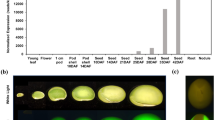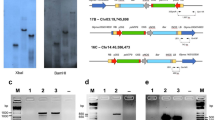Abstract
Besides biotin-dependent carboxylases, which play key roles in basic metabolism, SBP65 (seed biotinylated protein of 65 kDa of apparent molecular mass), an atypical biotinylated protein, has been described in pea plants. This seed-specific protein is devoid of any carboxylase activity, and shares many physiological and molecular features with late embryogenesis-abundant (Lea) proteins. In a first step toward understanding the role of this peculiar protein, we have demonstrated the role of abscisic acid (ABA) and of the osmotic environment on its expression using northern blot analysis from immature embryos cultured in vitro and germinating mature seeds. Moreover, the cloning and characterization of its gene (referred to as sbp gene) allowed us to define various potential cis-acting elements within the promoter region to account for the observed strict seed-specific expression. The results described in this paper are consistent with a model in which ABA regulates, at least in part, expression of this gene. However, unlike most lea genes, ABA regulation of the sbp gene seems to occur in a very restricted fashion, being confined only to particular stages of embryo development. Such a strict spatial and temporal expression pattern is dependent on the osmotic environment of the developing embryos and on tissue-specific factors, presumably preventing biotin depletion in cells requiring this essential cofactor for basic metabolic activity.
Similar content being viewed by others
References
Aubert S, Alban C, Bligny R, Douce R: Induction ofβ-methylcrotonyl-coenzyme A carboxylase in higher plant cells during carbohydrate starvation: evidence for a role of MCCase in leucine catabolism. FEBS Lett 338: 175–180 (1996).
Baldet P, Alban C, Axiotis S, Douce R: Localization of free and bound biotin in cells from green pea leaves. Arch Biochem Biophys 303: 67–73 (1993).
Baldet P, Gerbling H, Axiotis S, Douce R: Biotin synthesis in higher plant cells. Identification of intermediates. Eur J Biochem 217: 479–485 (1993).
Barker DF, Campbell AM: The birA gene of Escherichia coli encodes a biotin holoenzyme synthetase. J Mol Biol 146: 451–467 (1981).
Barratt DHP, Clark JA: Proteins arising during the late stages of embryogenesis in Pisum sativum L. Planta 184: 14–23 (1991).
Barratt DHP, Whitford PN, Cook SK, Butcher G, Wang TL: An analysis of seed development in Pisum sativum. VIII. Does abscisic acid prevent precocious germination and control storage protein synthesis? J Exp Bot 40: 1009–1014 (1989).
Bewley JD, Black M: Seeds: Physiology of Development and Germination, 2nd ed. Plenum Press, New York (1994).
Breathnach R, Chambon P: Organization and expression of eukaryotic split genes coding for proteins. Annu Rev Biochem 50: 349–383 (1981).
Bustos MM, Guiltinan MJ, Jordano J, Begum D, Kalkan FA, Hall TC: Regulation ofβ-glucuronidase expression in transgenic tobacco plants by an A/T-rich cis-acting sequence found upstream of a French bean β-phaseolin gene. Plant Cell 1: 839–853 (1989).
Craft DV, Goss NH, Chandramouli N, Wood HG: Purification of biotinidase from human plasma and its activity on biotinyl peptides. Biochemistry 24: 2471–2476 (1985).
Dakshinamurti K, Chauhan J: Biotin. Vitamins and Hormones 45: 337–384.
de Bruijn SM, Buddendorf CJJ, Vreugdenhil D: Characterization of the ABA-deficient Pisum sativum 'wilty' mutant. Acta Bot Neerl 42: 491–503 (1993).
Dehaye L, Alban C, Job C, Douce R, Job D: Kinetics of the two forms of acetyl-CoA carboxylase from Pisum sativum. Correlation of the substrate specificity of the enzyme and sensitivity towards aryloxyphenoxypropionates herbicides. Eur J Biochem 225: 1113–1123 (1994).
de Pater S, Pham K, Chua N-H, Memelink J, Kijne J: A 22-bp fragment of the pea lectin promoter containing essential TGAC-Iikemotifs confers seed-specific gene expression. Plant Cell 5: 877–886 (1993).
Donald RGK, Cashmore AR: Mutation of either G box or I box sequences profoundly affects expression from the Arabidopsis rbcS-1A promoter. EMBO J 9: 1717–1726 (1990).
Dumas R, Curien G, DeRose RT, Douce R: Branched-chainamino-acid biosynthesis in plants: molecular cloning and characterization of the gene encoding acetohydroxy acid isomeroreductase (ketol-acid reductoisomerase) from Arabidopsis thaliana (thale cress). Biochem J 294: 821–828 (1993).
Dure L III: The LEA proteins of higher plants. In Verma DPS (eds), Control of Plant Gene Expression, pp. 325–335. CRC Press, Boca Raton, FL (1993).
Duval M: Ph. D. thesis, University of Grenoble, France (1995).
Duval M, Job C, Alban C, Douce R, Job D: Developmental patterns of free and protein-bound biotin during maturation and germination of seeds of Pisum sativum. Characterization 620 of a novel seed-specific biotinylated protein. Biochem J 299: 141–150 (1994).
Duval M, DeRose RT, Job C, Faucher D, Douce R, Job D: The major biotinyl protein from Pisum sativum seeds covalently binds biotin at a novel site. Plant Mot Biol 26: 265–273 (1994).
Duval M, Pépin R, Job C, Derpierre C, Douce R, Job D: Ultrastructural localization of the major biotinylated protein from Pisum sativum seeds. J Exp Bot 46: 1783–1786 (1995).
Duval M, Loiseau J, Dehaye L, Pépin R, LeDeunff Y, Wang T, Job D: SBP65, a seed-specific biotinylated protein behaves as a LEA protein in developing pea embryos. C R Acad Sci Paris 319: 585–594 (1996).
Galau GA, Hughes DW, Dure L III: Abscisic acid induction of cloned late embryogenesis-abundant (Lea) mRNAs. PlantMol Biol 7: 155–170 (1986).
Gomez J, Sanchez-Martinez D, Stiefel V, Rigau J, Pages PM: A gene induced by the plant hormone abscisic acid in response to water stress encodes a glycine-rich protein. Nature 334: 262–264 (1988).
Goldberg RB, Barker SJ, Perez-Grau L: Regulation of gene expression during plant embryogenesis. Cell 56: 149–160 (1989).
Goupil P, Hatzopoulos P, Franz G, Hempel FD, You R, Sung ZR: Transcriptional regulation of a seed-specific carrot gene, DC8. Plant Mol Biol 18: 1049–1063 (1992).
Guiltinan MJ, Marcotte WR, Quatrano RS: Aplant leucine zipper protein that recognizes an abscisic acid response element. Science 250: 267–271 (1990).
Hammond-Kosack MCU, Holdsworth MJ, Bevan MW: In vivo footprinting of a low molecular weight glutelin gene (LMWG-1D1) in wheat endosperm. EMBO J 12: 545–554 (1993).
Hatzopoulos P, Fong F, Sung ZR: Abscisic acid regulation of DC8, a carrot embryonic gene. Plant Physiol 94: 690–695 (1990).
Hill DE, Hope IA, Macke JP, Struhl K: Saturation mutagenesis of the yeast his3 regulatory site: requirements for transcriptional induction and for binding by GCN4 activator protein. Science 234: 451–457 (1986).
Iturriaga EA, Leech MJ, Barratt DHP, Wang TL: Two ABAresponsive proteins from pea (Pisum sativum L.) are closely related to intracellular pathogenesis-related proteins. Plant Mol Biol 24: 235–240 (1994).
Jendrisak J: The use ofα-amanitin to inhibit in vivo RNA synthesis and germination in wheat embryos. J Biol Chem 255: 8529–8533 (1980).
Joshi CP: An inspection of the domain between putative TATA box and translation start site in 70 plant genes. Nucl Acids Res 15: 6643-6653 (1987).
Kermode AR: Regulatory mechanisms in the transition from seed development to germination: interactions between the embryo and the seed environment. In: Kigel J, Galili G (eds) Seed Development and Germination, pp. 273–332. Marcel Dekker, New York (1995).
Knowles JR: The mechanism of biotin-dependent enzymes. Annu Rev Bioch 58: 195–221 (1989).
Léon-Del-Rio A, Gravel RA: Sequence requirement for the biotinylation of the carboxyl-terminal fragments of human propionyl-CoA carboxylase α subunit expressed in Escherichia coli. J Biol Chem 269: 22964–22968 (1994).
McLamore WM, Celmer WD, Bogert VV, Pennington FC, Sobin BA, Solomons IA: Structure and synthesis of a new, thialidone antibiotic. J Am Chem Soc 75: 105–108 (1953).
Michel BE, Kaufmann MR: The osmotic potential of polyethylene glycol 6000. Plant Physiol 51: 914–916 (1973).
Morris PC, Kumar A, Bowles DJ, Cuming AC: Osmotic stress and abscisic acid induce expression of the wheat Em genes. Eur J Biochem 190: 625–630 (1990).
Morton RL, Quiggin D, Higgins TJV: Regulation of seed storage protein gene expression. In: Kigel J, Galili G (eds) Seed Development and Germination, pp. 103–138. Marcel Dekker, New York (1995).
Mundy J, Chua N-H: Abscisic acid and water stress induce the expression of a novel rice gene. EMBO J 7: 2279–2286 (1988).
Mundy J, Yamaguchi-Shinozaki K, Chua N-H: Nuclear proteins bind conserved elements in the abscisic acid-responsive promoter of a rice rab gene. Proc Natl Acad Sci USA 87: 1406–1410 (1990).
Ogata K, lzumi Y, Tani Y: The controlling action of actithiazic acid on the biosynthesis of biotin vitamers by various organisms. Agri Biol Chem 37: 1079–1085 (1973).
Patton DA, Volrath S, Ward ER: Complementation of an Arabidopsis thaliana biotin auxotroph with an Escherichia coli biotin biosynthetic gene. Mol Gen Genet 251: 261–266 (1996).
Quatrano RS, Guiltinan MJ, Marcotte WR: Regulation of gene expression by abscisic acid. In: Verma DPS (ed) Control of Plant Gene Expression, pp. 69–90. CRC Press, Boca Raton, FL (1993).
Ransone I-J, Verma MI: Nuclear proto-oncogenes FOS and JUN. Annu Rev Cell Biol 6: 539–557 (1990).
Roesler KR, Savage LJ, Shorrosh BS, Ohlrogge JB: Copurification, co-immunoprecipitation, and coordinate expression of acetyl-coenzyme A carboxylase activity, biotin carboxylase, and biotin carboxyl carrier protein of higher plants. Planta 198: 517–525 (1996).
Sambrook J, Fritsch EF, Maniatis T: Molecular Cloning: A Laboratory Manual, 2nd ed. Cold Spring Harbor Laboratory Press, Cold Spring Harbor, NY (1989).
Samols D, Thornton CG, Murtif VL, Kumar GK, Haase FC, Wood HG: Evolutionary conservation among biotin enzymes. J Biol Chem 263: 6461–6464 (1988).
Sanger F, Nicklen S, Coulson AR: DNA sequencing with chainterminating inhibitors. Proc Natl Acad Sci USA 74: 5463–5467 (1977).
Schatz PJ: Use of peptide libraries to map the substrate specificity of a peptide-modifying enzyme: a 13 residue consensus peptide specifies biotinylation in Escherichia coli. Bio/technology 11: 1138–1143 (1993).
Shellhammer J, Meinke D: Arrested embryos from the bio1 auxotroph of Arabidopsis thaliana contain reduced levels of biotin. Plant Physiol 93: 1162–1167 (1990).
Shu TF, Hsieh KL, Hsing YI, Chen ZY, Chow TY: Accession number in GenBank to glycine max 68 kDa Lea protein cDNA: U59626 (1996).
Tissot G, Job D, Douce R, Alban C: Protein biotinylation in higher plants: characterization of biotin holocarboxylase synthetase activity from pea (Pisum sativum) leaves. Biochem J 314: 391–395 (1996).
Wang X, Wurtele ES, Nikolau BJ: Regulation ofβ-methylcrotonyl-coenzyme Acarboxylase activity by biotinylation of the apoenzyme. Plant Physiol 108: 1133-1139 (1995).
Wurtele ES, Nikolau BJ: Plants contain multiple biotin enzymes. Discovery of 3-methylcrotonyl-CoA carboxylase, propionyl-CoA carboxylase and pyruvate carboxylase in the plant kingdom. Arch Biochem Biophys 278: 179–186 (1990).
Wurtele ES, Nikolau BJ: Differential accumulation of biotin enzymes during carrot somatic embryogenesis. Plant Physiol 99: 1699–1703 (1992).
Yang LJ, Barratt DHP, Domoney C, Hedley CL, Wang TL: An analysis of seed development in Pisum sativum. X. Expression of storage protein genes in cultured embryos. J Exp Bot 41: 283–288 (1990).
Yaxley JL, Weller JL, Reid JB: A novel viviparous mutant (vip). Pisum Genet 28: 24–28 (1996).
Yoshihara T, Washida H, Takaiwa F: A 45-bp proximal region containing AACA and GCN4 motif is sufficient to confer endosperm-specific expression of the rice storage protein glutelin gene, GluA-3. FEBS Lett 383: 213–218 (1996).
Author information
Authors and Affiliations
Rights and permissions
About this article
Cite this article
Dehaye, L., Duval, M., Viguier, D. et al. Cloning and expression of the pea gene encoding SBP65, a seed-specific biotinylated protein. Plant Mol Biol 35, 605–621 (1997). https://doi.org/10.1023/A:1005836405211
Issue Date:
DOI: https://doi.org/10.1023/A:1005836405211




